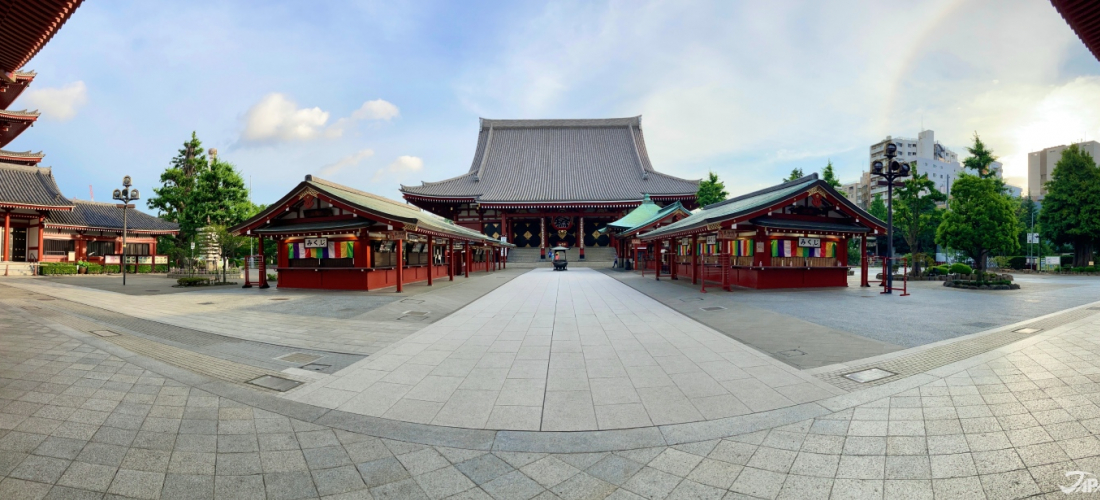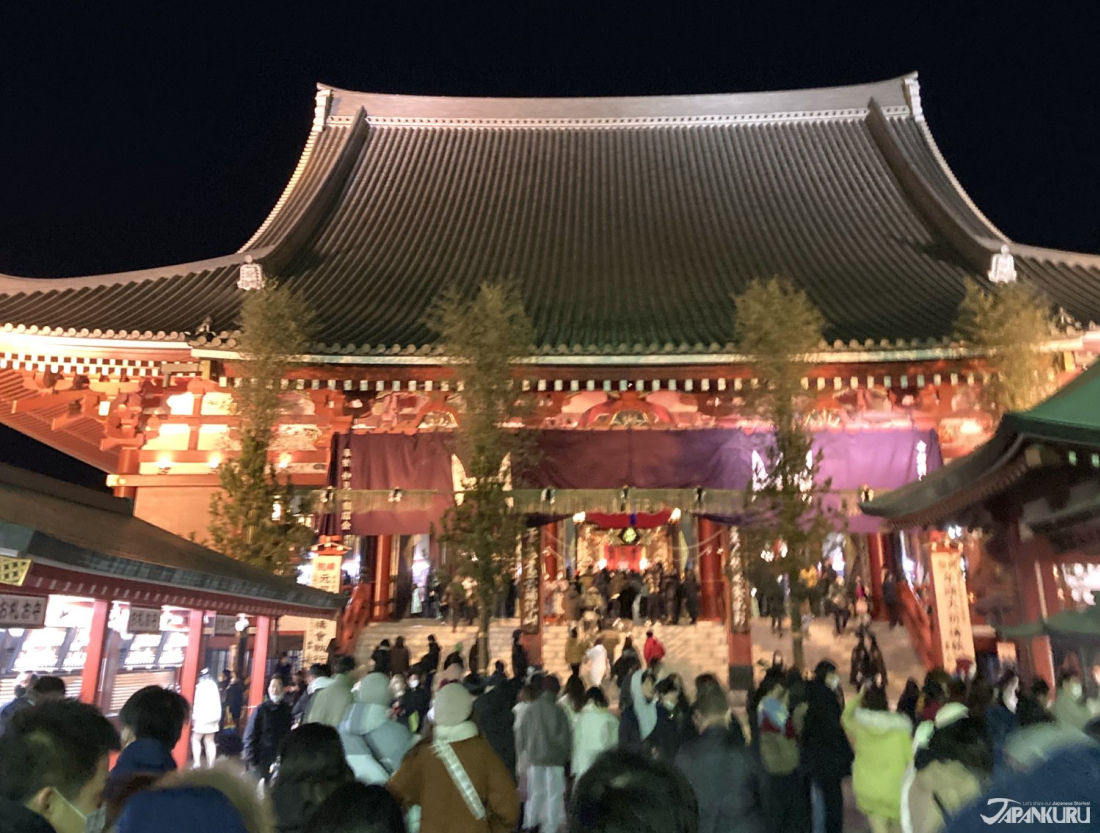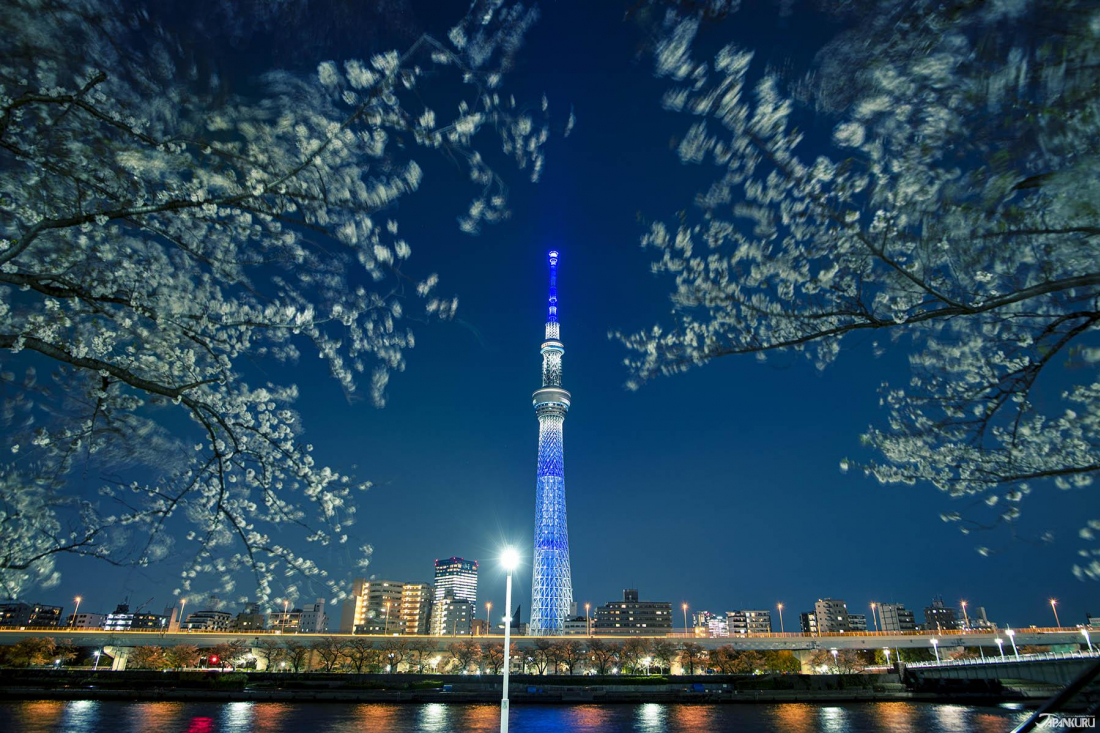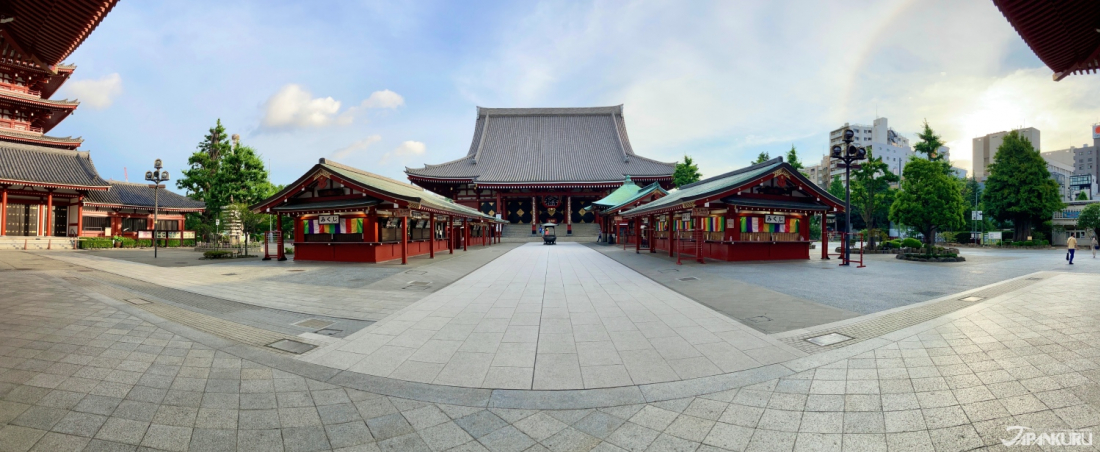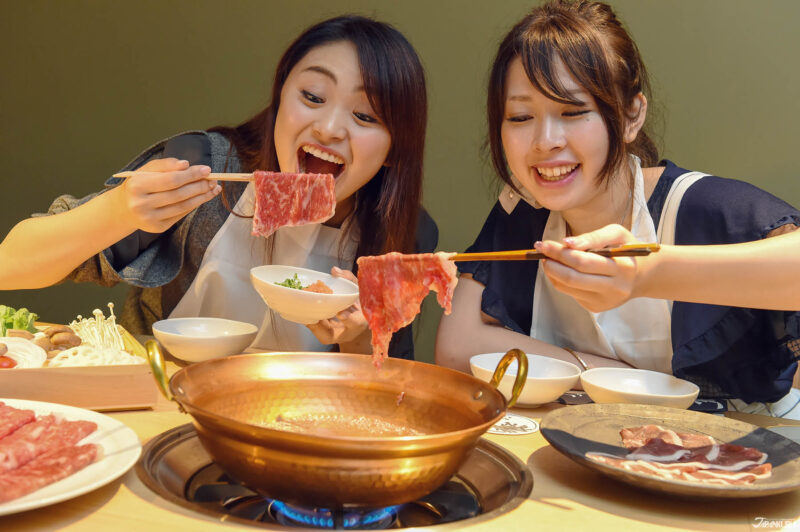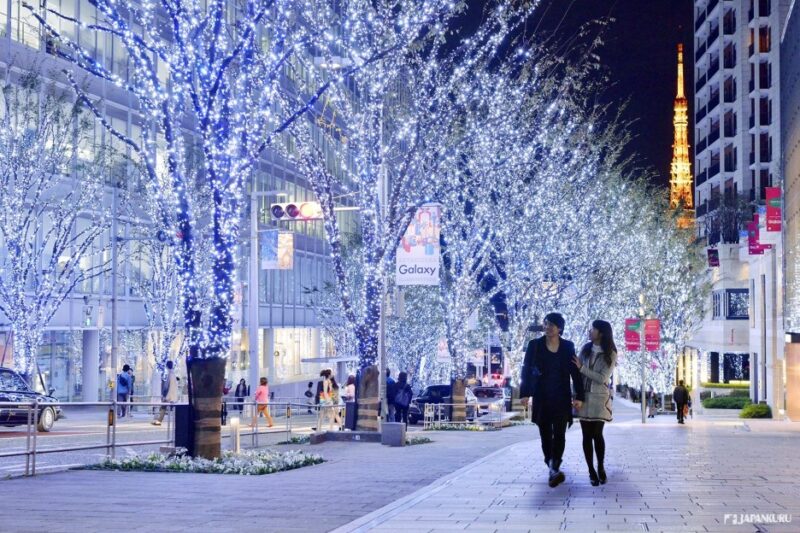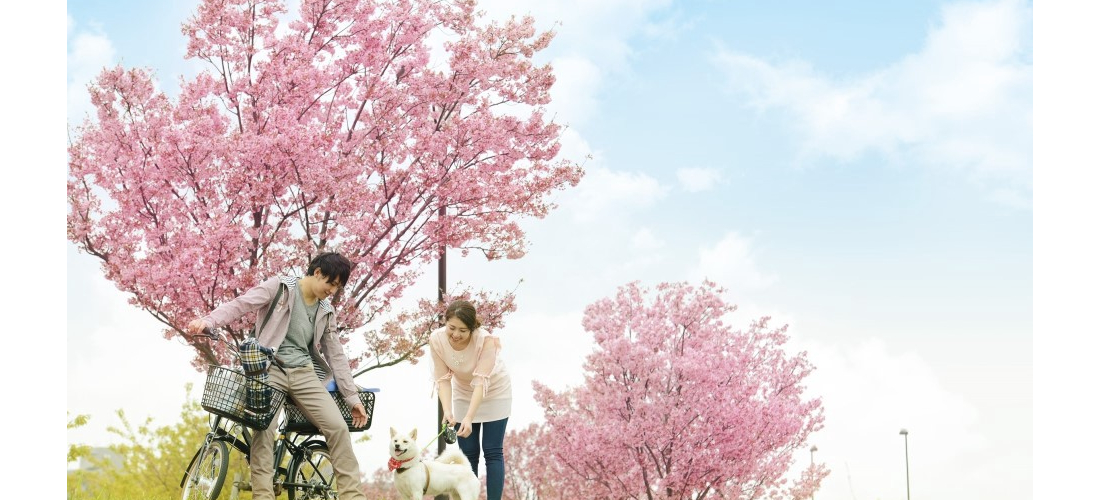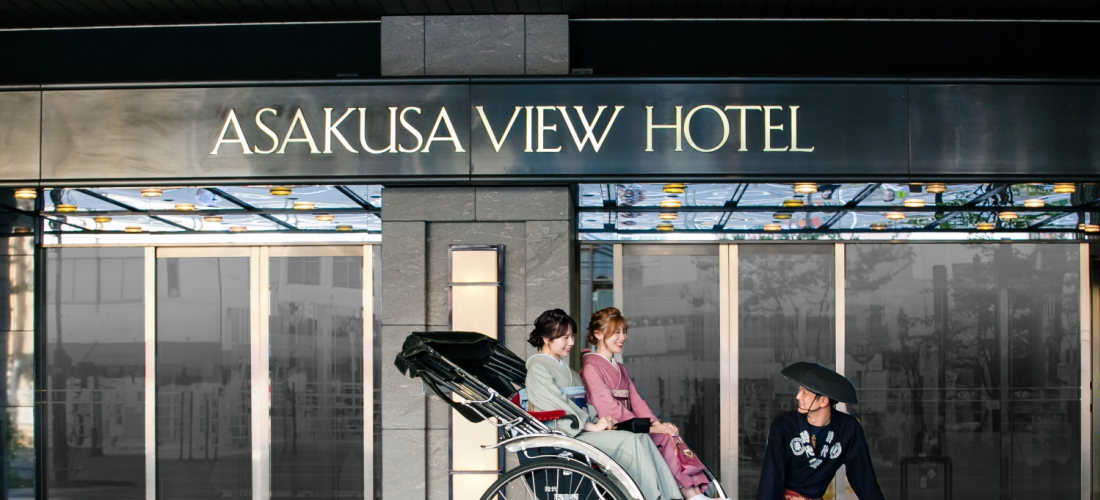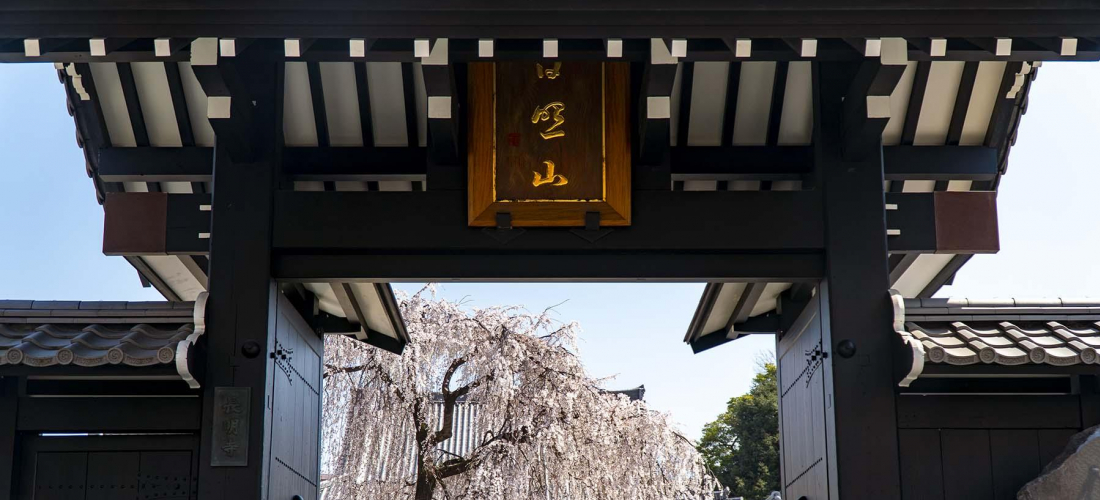CONTENTS
Visit this must-see Tokyo sightseeing spot for centuries of history, beautiful traditions, old-fashioned shopping, and lively crowds!
Sensoji Temple
Sensoji Temple is Tokyo's oldest Buddhist temple, located in the geographical and cultural heart of the city's Asakusa neighborhood, and these days it's at the top of the list of Tokyo must-sees. Travelers flock to the temple to see the grandiose Kaminarimon gate, with an enormous paper lantern hanging over year, and to walk down the crowded path connecting the temple to the street, lively with sightseers browsing the many little stalls, before entering the calm of the main hall dedicated to Kannon Bosatsu. Not only is there lots to see and do at this ancient attraction, but the unique atmosphere found only at Sensoji Temple makes it a sight to be seen.
Sensoji’s History
It might not look that old, but Sensoji Temple has been standing guard over Asakusa for almost a millennium and a half, since its establishment all the way back in the year 645. Legend tells of two brothers who found a statue of Kannon Bosatsu while fishing in the Sumida River, and supposedly went on to create a temple to enshrine this goddess of mercy. Of course, back then Tokyo wasn't the grand capital we see today, and the temple wasn't nearly so majestic.
During the Edo period (1603-1868) Sensoji Temple became a popular site for religious pilgrims, Ieyasu Tokugawa (a "great unifier of Japan" and the country's first shogun) became something of a patron, and like many popular temple neighborhoods in Japan, the area was transformed from a rural destination into a prosperous cultural center. Of course, Sensoji doesn't show its age, and that's because the buildings themselves have been burned in fires and rebuilt a number of times throughout the centuries. The main hall of the temple built in 1649 actually survived more than 300 years, and was even standing after the 1923 Great Kanto Earthquake destroyed much of Tokyo, but it was eventually burnt to the ground during the firebombing of 1945. But despite the 1950s construction date of the current temple buildings, they carry on the centuries-old traditions of Sensoji Temple, and the history can be felt all around.
What to Do at Sensoji Temple
Most people start their visit to Sensoji at the impressive main gate, called Kaminarimon, which is so iconic that it has now become a symbol of Tokyo. The paved area in front of the gate is constantly busy with people taking photos in front of the big red lantern, and during busy vacation seasons, you're likely to find people taking snapshots at any hour of the day or night! Don't miss the chance to take your own picture in front of this piece of history.
Kaminarimon (雷門) means "thunder gate," and that dramatic moniker is what's written on the front of the lantern as well. But the formal title of this official entrance gate is actually Furaijinmon (風雷神門), meaning Wind and Thunder God Gate, which explains the "thunder gate" nickname. You can actually see the full name written on the other side of the lantern!
Sensoji's Nakamise shopping street was once full of shops catering to religious pilgrims, but these days the many little stalls sell knickknacks and souvenirs, plus tasty snacks and much-needed refreshments of all kinds to the many sightseers who pass through each day. Keep an eye out for traditional Japanese treats like dango (mochi-like dumplings), senbei rice crackers, and even Asakusa's famous cream-filled melon bread (which is not made with melons).
When you finally make it through the crowd of busy shoppers, you'll find yourself facing the temple's enormous main halls, where you can go to pray to Kannon Bosatsu. As a busy temple, people come to pray every day of the year, but the busiest day of all is almost certainly New Year's Day! Sensoji Temple is a popular spot for hatsumode, Japan's tradition of visiting shrines and temples during the first day or so of the first year. The photo above actually shows the lively, jostling crowd in front of the main hall of Sensoji at three in the morning on January 1st!
When you finally get to the front of the line, it's standard to toss a five yen coin into the donation box before praying in Japan, because the words for "five yen" and "destiny" sound similar in Japanese! They say that Kannon Bosatsu can bless you with prosperity, safety, academic success, and health, while warding off disaster, so be sure to tell her your name and where to find you.
Finally, there are a few fun things to do at the temple that will give you a little memento to bring home, too! Sensoji is a great place to start a collection of goshuin (stamps and calligraphy collected from temples and shrines), especially since they sell goshuincho (goshuin books) with some pretty cool designs on the front. Goshuin collecting has been growing in popularity among locals and travelers alike, and there's no better time to start this hobby than now! Many people like to browse Sensoji's omamori, as well, and pick out one of the traditional good luck charms to take home. These colorful little fabric charms are especially popular among those looking to bring home a little luck to help with passing exams, avoiding traffic accidents, and maybe even finding love!
Finally, no visit to Sensoji Temple is complete without a trip to the omikuji counters set up in front of the main hall, to find your fortune! These little paper fortunes are offered at many temples and shrines, but Sensoji's omikuji are notoriously… varied. Unlike most temples, it's not unusual to get a mediocre fortune (or even a downright negative one) at Sensoji, so if you do walk away with a really good fortune, it's truly an exciting occasion.
What to Do Nearby
Located in among the covered shopping streets and narrow alleys of Asakusa, it's not hard to spend a whole day wandering around Sensoji Temple's surroundings and just enjoying the atmosphere. Many people choose to rent a kimono nearby, visit the temple, and spend the rest of the day just enjoying Asakusa, strolling through the busy streets, or snacking on the local street food.
That's not all the area has to offer, though! The eastern border of the Asakusa neighborhood is formed by Tokyo's Sumida River, and when the weather's nice, a riverside stroll through Sumida Park is an ideal break from the noisy crowds of the temple area. During late March and early April, the park becomes especially popular as the trees planted along the water bloom with cherry blossoms, turning the park into a go-to hanami spot. Travelers looking for a longer walk can even cross the river, do some window-shopping at the shops along the Kitajukken Canal, and make their way over to Tokyo Skytree (only about a 20-minute walk from Sensoji)!
Going in the opposite direction, other popular areas like Ueno (home to Ueno Park, Ueno Zoo, and Ameyoko) or Akihabara (home to arcades, maid cafes, and plenty of nerdy shopping) are each only about 5 minutes away on the subway Ginza Line or Tsukuba Express train, respectively. There are lots of ways to make a day out of a trip to Sensoji Temple, so don't miss this must-see Tokyo destination!
For more info and updates from Japan, check Japankuru for new articles, and don't forget to follow us on Twitter, Instagram, and Facebook!
Details
NAME:Sensoji Temple (浅草寺)
ACCESS:Asakusa Station (浅草駅)
COMMENT
FEATURED MEDIA
VIEW MORE 
A New Tokyo Animal Destination: Relax & Learn About the World’s Animals in Japan
#pr #japankuru #anitouch #anitouchtokyodome #capybara #capybaracafe #animalcafe #tokyotrip #japantrip #카피바라 #애니터치 #아이와가볼만한곳 #도쿄여행 #가족여행 #東京旅遊 #東京親子景點 #日本動物互動體驗 #水豚泡澡 #東京巨蛋城 #เที่ยวญี่ปุ่น2025 #ที่เที่ยวครอบครัว #สวนสัตว์ในร่ม #TokyoDomeCity #anitouchtokyodome

Shohei Ohtani Collab Developed Products & Other Japanese Drugstore Recommendations From Kowa
#pr #japankuru
#kowa #syncronkowa #japanshopping #preworkout #postworkout #tokyoshopping #japantrip #일본쇼핑 #일본이온음료 #오타니 #오타니쇼헤이 #코와 #興和 #日本必買 #日本旅遊 #運動補充能量 #運動飲品 #ช้อปปิ้งญี่ปุ่น #เครื่องดื่มออกกำลังกาย #นักกีฬา #ผลิตภัณฑ์ญี่ปุ่น #อาหารเสริมญี่ปุ่น

도쿄 근교 당일치기 여행 추천! 작은 에도라 불리는 ‘가와고에’
세이부 ‘가와고에 패스(디지털)’ 하나면 편리하게 이동 + 가성비까지 완벽하게! 필름카메라 감성 가득한 레트로 거리 길거리 먹방부터 귀여움 끝판왕 핫플&포토 스폿까지 총집합!
Looking for day trips from Tokyo? Try Kawagoe, AKA Little Edo!
Use the SEIBU KAWAGOE PASS (Digital) for easy, affordable transportation!
Check out the historic streets of Kawagoe for some great street food and plenty of picturesque retro photo ops.
#pr #japankuru #도쿄근교여행 #가와고에 #가와고에패스 #세이부패스 #기모노체험 #가와고에여행 #도쿄여행코스 #도쿄근교당일치기 #세이부가와고에패스
#tokyotrip #kawagoe #tokyodaytrip #seibukawagoepass #kimono #japantrip

Hirakata Park, Osaka: Enjoy the Classic Japanese Theme Park Experience!
#pr #japankuru #hirakatapark #amusementpark #japantrip #osakatrip #familytrip #rollercoaster #retrôvibes #枚方公園 #大阪旅遊 #關西私房景點 #日本親子旅行 #日本遊樂園 #木造雲霄飛車 #히라카타파크 #สวนสนุกฮิราคาตะพาร์ค

🍵Love Matcha? Upgrade Your Matcha Experience With Tsujiri!
・160년 전통 일본 말차 브랜드 츠지리에서 말차 덕후들이 픽한 인기템만 골라봤어요
・抹茶控的天堂!甜點、餅乾、飲品一次滿足,連伴手禮都幫你列好清單了
・ส่องมัทฉะสุดฮิต พร้อมพาเที่ยวร้านดังในอุจิ เกียวโต
#pr #japankuru #matcha #matchalover #uji #kyoto #japantrip #ujimatcha #matchalatte #matchasweets #tsujiri #말차 #말차덕후 #츠지리 #교토여행 #말차라떼 #辻利抹茶 #抹茶控 #日本抹茶 #宇治 #宇治抹茶 #日本伴手禮 #抹茶拿鐵 #抹茶甜點 #มัทฉะ #ของฝากญี่ปุ่น #ชาเขียวญี่ปุ่น #ซึจิริ #เกียวโต

・What Is Nenaito? And How Does This Sleep Care Supplement Work?
・你的睡眠保健品——認識「睡眠茶氨酸錠」
・수면 케어 서플리먼트 ‘네나이토’란?
・ผลิตภัณฑ์เสริมอาหารดูแลการนอน “Nenaito(ネナイト)” คืออะไร?
#pr #japankuru #sleepcare #japanshopping #nenaito #sleepsupplement #asahi #睡眠茶氨酸錠 #睡眠保健 #朝日 #l茶胺酸 #日本藥妝 #日本必買 #일본쇼핑 #수면 #건강하자 #네나이토 #일본영양제 #อาหารเสริมญี่ปุ่น #ช้อปปิ้งญี่ปุ่น #ร้านขายยาญี่ปุ่น #ดูแลตัวเองก่อนนอน #อาซาฮิ

Japanese Drugstore Must-Buys! Essential Items from Hisamitsu® Pharmaceutical
#PR #japankuru #hisamitsu #salonpas #feitas #hisamitsupharmaceutical #japanshopping #tokyoshopping #traveltips #japanhaul #japantrip #japantravel

Whether you grew up with Dragon Ball or you just fell in love with Dragon Ball DAIMA, you'll like the newest JINS collab. Shop this limited-edition Dragon Ball accessory collection to find some of the best Dragon Ball merchandise in Japan!
>> Find out more at Japankuru.com! (link in bio)
#japankuru #dragonball #dragonballdaima #animecollab #japanshopping #jins #japaneseglasses #japantravel #animemerch #pr

This month, Japankuru teamed up with @official_korekoko to invite three influencers (originally from Thailand, China, and Taiwan) on a trip to Yokohama. Check out the article (in Chinese) on Japankuru.com for all of their travel tips and photography hints - and look forward to more cool collaborations coming soon!
【橫濱夜散策 x 教你怎麼拍出網美照 📸✨】
每次來日本玩,是不是都會先找旅日網紅的推薦清單?
這次,我們邀請擁有日本豐富旅遊經驗的🇹🇭泰國、🇨🇳中國、🇹🇼台灣網紅,帶你走進夜晚的橫濱!從玩樂路線到拍照技巧,教你怎麼拍出最美的夜景照。那些熟悉的景點,換個視角說不定會有新發現~快跟他們一起出發吧!
#japankuru #橫濱紅磚倉庫 #汽車道 #中華街 #yokohama #japankuru #橫濱紅磚倉庫 #汽車道 #中華街 #yokohama #yokohamaredbrickwarehouse #yokohamachinatown

If you’re a fan of Vivienne Westwood's Japanese designs, and you’re looking forward to shopping in Harajuku this summer, we’ve got important news for you. Vivienne Westwood RED LABEL Laforet Harajuku is now closed for renovations - but the grand reopening is scheduled for July!
>> Find out more at Japankuru.com! (link in bio)
#japankuru #viviennewestwood #harajuku #omotesando #viviennewestwoodredlabel #viviennewestwoodjapan #비비안웨스트우드 #오모테산도 #하라주쿠 #日本購物 #薇薇安魏斯伍德 #日本時尚 #原宿 #表參道 #japantrip #japanshopping #pr

Ready to see TeamLab in Kyoto!? At TeamLab Biovortex Kyoto, the collective is taking their acclaimed immersive art and bringing it to Japan's ancient capital. We can't wait to see it for ourselves this autumn!
>> Find out more at Japankuru.com! (link in bio)
#japankuru #teamlab #teamlabbiovortex #kyoto #kyototrip #japantravel #artnews
Photos courtesy of teamLab, Exhibition view of teamLab Biovortex Kyoto, 2025, Kyoto ® teamLab, courtesy Pace Gallery

Japanese Makeup Shopping • A Trip to Kamakura & Enoshima With Canmake’s Cool-Toned Summer Makeup
#pr #canmake #enoshima #enoden #에노시마 #캔메이크 #japanesemakeup #japanesecosmetics

⚔️The Robot Restaurant is gone, but the Samurai Restaurant is here to take its place. Check it out, and don't forget your coupon!
🍣신주쿠의 명소 로봇 레스토랑이 사무라이 레스토랑으로 부활! 절찬 쿠폰 발급중
💃18歲以上才能入場的歌舞秀,和你想的不一樣!拿好優惠券去看看~
#tokyo #shinjuku #samurairestaurant #robotrestaurant #tokyotrip #도쿄여행 #신주쿠 #사무라이레스토랑 #이색체험 #할인이벤트 #歌舞伎町 #東京景點 #武士餐廳 #日本表演 #日本文化體驗 #japankuru #japantrip #japantravel #japanlovers #japan_of_insta

Japanese appliance & electronics shopping with our KOJIMA x BicCamera coupon!
用JAPANKURU的KOJIMA x BicCamera優惠券買這些正好❤️
코지마 x 빅 카메라 쿠폰으로 일본 가전 제품 쇼핑하기
#pr #japankuru #japanshopping #kojima #biccamera #japaneseskincare #yaman #dji #osmopocket3 #skincaredevice #日本購物 #美容儀 #相機 #雅萌 #日本家電 #일본여행 #면세 #여행꿀팁 #일본쇼핑리스트 #쿠폰 #일본쇼핑 #일본브랜드 #할인 #코지마 #빅카메라 #japankurucoupon

